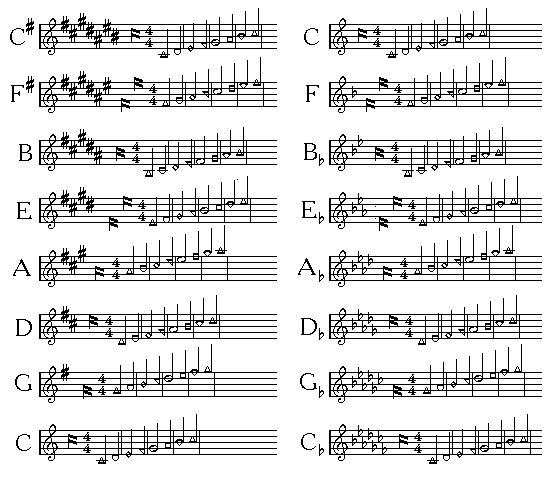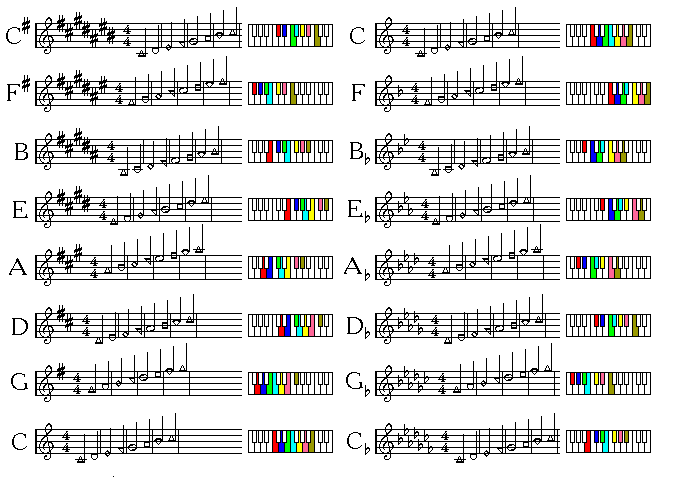
The key signatures for the keys, from C sharp through C flat, are illustrated below:

After each key signature, the notes of the major scale, from do back to do, in that key are shown, in shape-note notation, which makes it clear which degree of the scale each note belongs to. Also, there is a color-coded image of the piano keyboard, showing the locations of the notes on each degree of the scale, as they are displaced in the different keys.
Shape-notes were used in some old church hymnals, to make it easier for members of a congregation without specific musical training to read the melody of a hymn from the musical score. In the form of shape-note notation used here, the Aikin system, a different shape is associated with each of the seven degrees of the scale. Older systems of shape-notes used only four shapes, those used also in the Aikin system for mi, fa, so,and la.
I have seen a modern book of music written to be played easily in which "do", "re", "mi", and so on were printed inside the note itself to accomplish a similar end.
Another system, also used for hymn books, that indicated each degree of the scale with a different design for each note was the Hood system, shown in the diagram following on the line below one with the Aikin system:
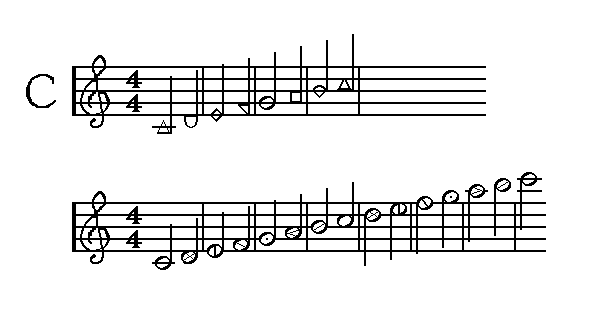
Because this system was proprietary, however, it failed to achieve widespread popularity. Note that the markings used in the notes were designed to indicate the normal melodic progression from each degree of the scale: do, mi, and so are at repose, fa tends to move to mi, ti tends to move to do, and re and la, while they also tend to move, may move in either direction.
Some sheet music designed to be played easily on the Hammond organ used one alternate shape for notes, the square, for another purpose: notes to be played as sharps, or as flats, because of the key signature were printed as square notes, so that it would be obvious when to use the black keys while playing.
Incidentally, one can see from the image above why so much popular music is in the keys of E flat, F, or G, compared to the key of C. Those three keys, with only one (or, in one case, three) notes played on the black keys of the piano, all have their tonic located close to the bottom of the treble staff. Because the range of the treble staff was chosen to correspond to the capabilities of the singing voice, melodies in those keys are convenient to sing (not merely to write, through avoiding leger lines).
Or ledger lines; amazingly enough, both terms are considered correct. Well, I suppose those tiny lines can equally well be considered light lines, because they are short, and ledges upon which notes rest.
This chart illustates the appearance of the key signatures in the other staffs, as well as providing some information about musical notation:
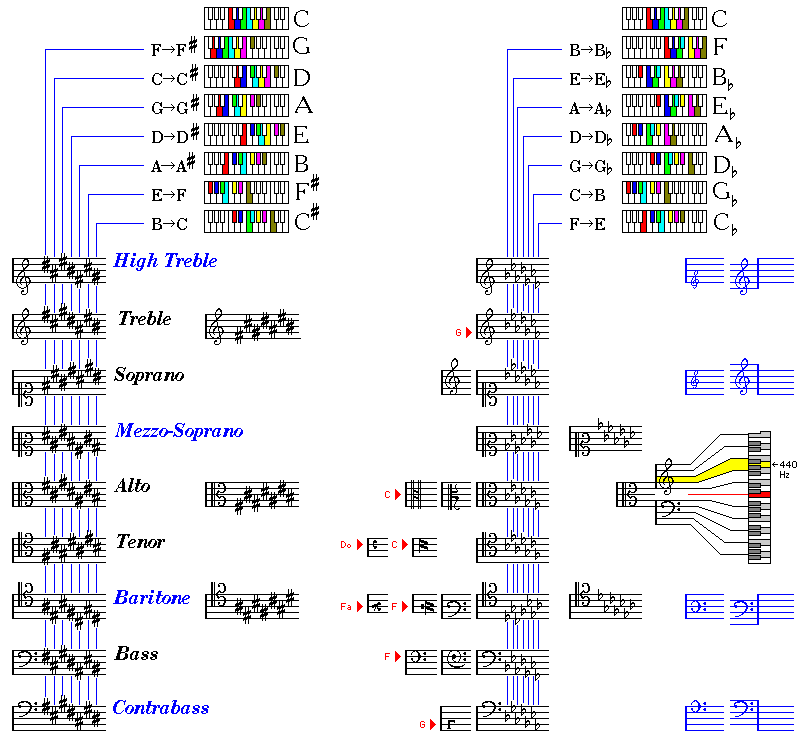
Thus, we see from this chart that the single sharp in the key signature of the key of G is on the line for the note F, which it changes to F sharp, and, similarly, the single flat in the key signature of the key of F is on the line for the note B, which it changes to B flat. Again, the diagrams of small piano keyboards are present, showing the mapping of the steps of the major scale to the notes in the various keys.
Note that the flat signs in the key signatures for most of the basic staffs shown, except for the mezzo-soprano and baritone staffs, which have largely fallen into disuse, are in two rows gently sloping down. The sharp signs are written in a fashion which is the mirror-image of that for the soprano and tenor staffs. As the diagram shows, to the right of the illustration of how the sharps are normally placed in the treble staff, the sharps for key signatures in the treble staff could also be written that way. Usually, however, they are not.
This is because it would not be possible to write key signatures for the bass staff in this fashion, without requiring leger lines to write the key signature. Therefore, so that it is easier to automatically recognize the key signatures at sight for the two most common staffs, the treble and bass staffs, since it is possible, even if slightly more awkward, to write the sharps for the treble staff in the same fashion as for the bass staff, it is done that way.
Thus, in the case of key signatures involving sharps, the scheme that must, of necessity, be employed for the bass staff is also used for the treble staff, since it can be used there. These being the two most common staves, this has the advantage of making it easier to recognize the different keys at sight. That the different, simpler, scheme used for flats has to be used for the soprano and tenor staves is acceptable, as they are seldom used.
In the case of key signatures involving flats, the simpler arrangement works for both the treble staff and the bass staff. The two staves for which it does not work, the mezzo-soprano staff and the baritone staff, could simply be allowed to fall into disuse; and, indeed, this has been the case since at least the middle of the nineteenth century.
If one goes back even further, to Jean-Baptiste Lully, a composer of the seventeenth century, one can find a staff he used for the violin in some of his compositions, in which the G clef was placed on the bottom line; this would be equivalent to using the bass staff, and playing the notes two octaves higher than written. This is the high treble staff; also shown in the diagram is a staff below the bass staff, the contrabass staff. In the time of Palestrina, both the high treble staff and the contrabass staff were acknowledged as part of the system of staves.
And, of course, there's always Gregorian chant, where four lines, rather than five, are used to draw the staff. In the lower middle of the diagram, the two clefs used for Gregorian chant are noted; rather than standing for the notes C and F, they stand for the degrees of the diatonic scale, irrespective of key; instead of standing for C, the one shown in the upper scale stands for Do, and instead of standing for F, the one shown in the lower scale stands for Fa. Following them are modernized forms of the same symbols as once used in the Anglican hymnal; these symbols, however, do stand for notes rather than degrees of the scale; the notation used by the Church of England for Gregorian chant admits of the use of the symbol for the flat.
On the right of the diagram, along with the flatted key signatures, it is noted that the symbol for the treble staff is intended to indicate that the line on the staff which forms the visual center of its spiral portion is the note G above middle C. Similarly, the symbol for the alto staff indicates the line for middle C, and the bass staff indicates the line which is the note F below middle C. Alternate older forms of these symbols are shown as well. Also shown in the diagram, as an alternate way to indicate the contrabass staff, is the Greek capital letter gamma, used as a clef to indicate the G two octaves below that indicated by the normal G clef.
Thus, the symbol indicating the treble staff is called the G clef; the symbol indicating the alto staff is called the C clef; and the symbol indicating the bass staff is called the F clef.
The tenor staff is indicated by a C clef that is raised to the next higher line on the staff. The soprano staff is indicated by a C clef that is lowered by two lines. It could equally well be indicated by a G clef that is raised by one line. While this was done at one time, since the treble staff is so commonly used, it was very easy for people to carelessly mistake a soprano staff for a treble staff, by simply assuming that anything with a G clef must be a treble staff. The C clef, being less commonly used, and already being used for the tenor staff, reminds people to check where it is centered; as well, the symbols for the C clef, in their older forms as well as their current form, make the line about which they are centered more obvious than the G clef does.
Similarly, the baritone (or barytone) staff, when it was used, was written with an F clef lowered by one line, but if it were used today, it would be written instead with a C clef raised by two lines.
One way in which the confusion that could be caused by using the F clef to indicate the baritone staff, and by using the contrabass staff, or by using the G clef to indicate the soprano staff, and by using the high treble staff, could be avoided is also illustrated in the diagram. If the present form of the F clef is used when it indicates the bass staff, but an older form is used when it is displaced to indicate the baritone staff or the contrabass staff, the problem of confusion should be effectively avoided. In the case of the G clef, it would seem that this remedy is not available, since while both the C clef and the F clef had alternate forms that were in relatively recent use, the present form of the G clef is considerably older. Rather than using one of the very old forms of the G clef, which would appear out of place in modern musical notation, I propose using a G clef reduced in size to one-half of its normal height to indicate the soprano and high treble staves. That this would also somewhat suggest the appearance of the antique forms of the G clef is a nice bonus.
Another possibility, also illustrated in blue beside that one, would be to place the C and G clefs in their usual places on the staff, then having the staff jog upward or downward to the staff that is actually to be used.
Incidentally, it certainly is true that the conventional system of musical notation impresses an outsider as confusing and inconsistent. Since there are seven degrees to the scale, but alternate lines and spaces are used, each note alternates between a line and a space.
This could be remedied by representing each octave either by three lines, with a wider space between each group of three lines, with the two notes in that wider space either touching the upper line or the lower one, perhaps something like this:
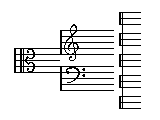
or by four lines, with a narrower space between each group of four lines. But doing so, while it might make it slightly easier to begin learning the piano, would not be worthwhile to other types of musician. The difficulty would remain that, depending on the key in which a piece is in, the tonic (Do) could be on either a line or a space.
One could even do away with sharps and flats by having a staff in which the lines correspond to the black keys on the piano, but this would cause music to take up more space; ever since Guido d'Arezzo presented the innovation of using both the lines and spaces of the staff, there has been little inclination to turn back.
Thus, one can understand why John Hullah, in his work A Short Treatise on the Stave, wrote "it is a curious fact that most, perhaps all, schemes for the reform of musical notation have been the invention of philosophers, mathematicians, divines, lawyers, physicians, poets, painters - of anybody, in short, but musicians."
Indeed, given that musicians, and indeed, many who are not musicians, have indeed long since memorized both the word "FACE", and the phrase "Every Good Boy Deserves Fudge", trying to solve the problem posed by any given note, such as C, sometimes appearing on a line of the staff, and sometimes on the space between two lines, is perhaps trying to solve a non-problem.
Well then, since this is the case, but since the high treble, mezzo-soprano, baritone, and contrabass staves have fallen into disuse as confusing, and, in fact, in some quarters, the alto staff is not used, but instead the treble staff is used, but with the notes indicated to be played or sung one octave lower than written, perhaps the thing to do is to take into account the fact that the treble staff does not need to be changed, because musicians have been capable of memorizing it thoroughly.
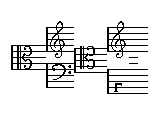
Thus, one could effect an improvement in the opposite direction; rather than reforming the staff in a radical manner, simply replace the alto staff with the treble staff lowered by one octave, and replace the bass staff with the treble staff lowered by two octaves. Thus, having memorized the one staff, the treble staff, with whatever logical imperfections it may have, one has memorized all the other staffs that are in use as well.
However, given that the shape-note system has been found beneficial in permitting church congregations to make use of printed sheet music with less need for extensive musical training, I am tempted to make one very modest proposal - and I hope not in the sense of Jonathan Swift - as follows:
Following the key signature of sharps or flats, but preceding the time signature, it might serve almost as useful as the use of shape-notes, but with less modification of the existing practice of typesetting music, if one were to place the tonic (or Do) clef of Gregorian chant - in the typographically modernized form as used in the Anglican hymnal, illustrated above - on the line or space that is the tonic of the major scale for that key. Using two of them, if two tonics come within the compass of the staff, would be of further assistance. I know that this seems like a crib, and thus an inducement to laziness, but it seems a small enough gesture.
That would give the key signatures the following appearance:
